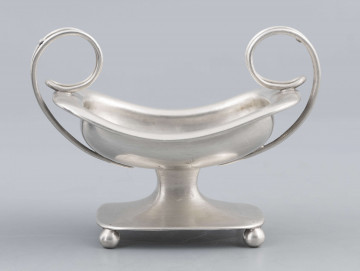
Salt cellar
1839 — 1850
National Museum in Lublin
Part of the collection: Craft and industry products of Szczecin
The box was made by Zacharias Kramer, a craftsman from Gdańsk, who has been listed in Szczecin’s city registers since 1711. The history of goldsmithing – an artistic craft aimed at making products out of gold, platinum, silver, metal alloys and precious stones, dates back to ancient times, and enjoyed particular popularity in ancient Greece, Rome and Byzantium. At that time, goldsmiths mainly made insignia of rulers – crowns, diadems, as well as decorative objects, such as caskets, figurines, boxes, tableware, and various types of jewellery – necklaces, buckles, rings, earrings. In the Middle Ages, the craft developed in monasteries and at the courts. In the 13th century, Western European goldsmiths established guilds and organisations. At the same time, new laws were introduced, which forced them to mark their products with a trademark of a master or workshop. In the modern period the most important goldsmithing centres included Venice, Rome, Augsburg, Paris and Nuremberg. The technological changes at the turn of the 19th and 20th centuries brought a new boom of this special craft.
Anna Lew-Machniak
Author / creator
Dimensions
cały obiekt: width: 8 cm
Object type
container
Creation time / dating
Creation / finding place
Identification number
Location / status

1839 — 1850
National Museum in Lublin

1832 — 1850
National Museum in Lublin

1832 — 1850
National Museum in Lublin
DISCOVER this TOPIC
Castle Museum in Łańcut
DISCOVER this PATH
Educational path